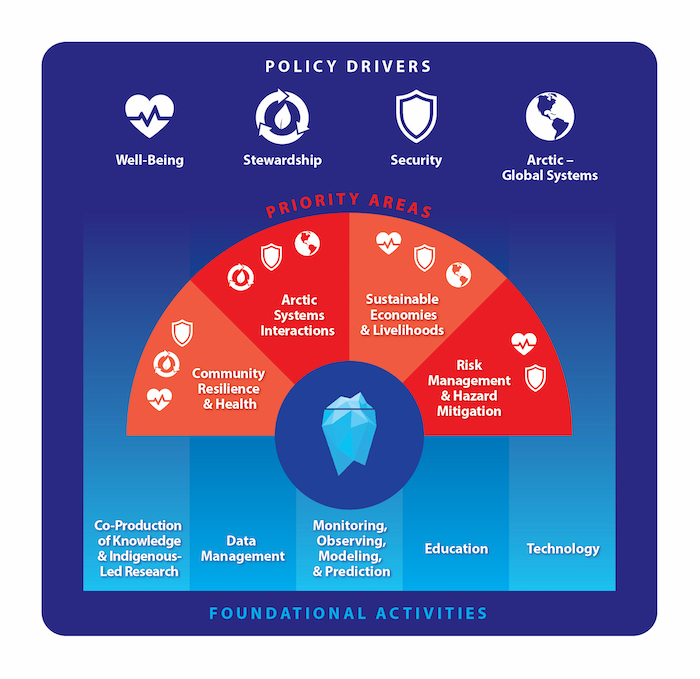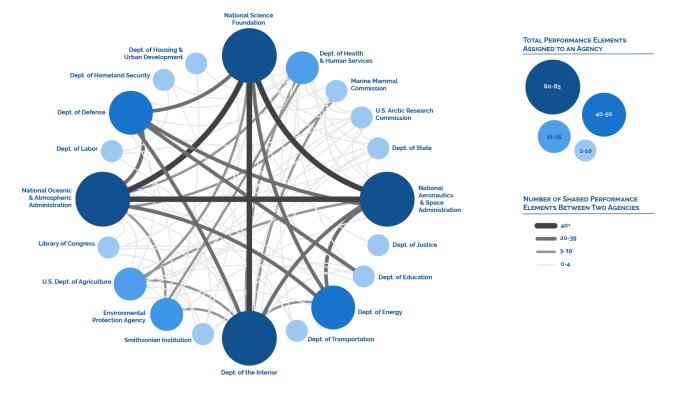By: The Interagency Arctic Research Policy Committee Staff
The Interagency Arctic Research Policy Committee (IARPC) brings together researchers from all over the US and around the world to work together on pressing issues facing the Arctic. Though the research world looked different this year amidst a global pandemic, IARPC collaboration teams came together to further the goals of the Arctic Research Plan (2017–2021). A complete summary of IARPC's accomplishments this year are now available in the 2020 Annual Report.
Throughout the year, all of the IARPC collaboration teams have navigated the challenges posed by COVID-19. Beginning in May 2020, the Environmental Intelligence Collaboration Team began working with the Alaska Ocean Observing System to compile and share information regarding the monthly status of planned research vessel activities in the Bering Strait and Chukchi and Beaufort seas region. Several other teams also held meetings on how to best protect both Arctic residents and researchers during the pandemic.
At the same time, the Environmental Intelligence, Marine Ecosystems, Coastal Resilience, and Sea Ice teams addressed changes in the Bering Sea. They brought together researchers, Indigenous Knowledge holders, resource managers, and policymakers to identify knowledge gaps and respond to concerns voiced by Arctic residents about unusual mortality events and the potential for harmful algal blooms.
Throughout the year, the Arctic Observing Systems Sub-Team supported development of a new National Science Foundation-supported research networking activity on coordinated observation of rapid Arctic change that launched in July 2020. The project lays the foundation for a food security-oriented information product integrating different types of coordinated observations, and includes Alaska Indigenous scholars as key leaders in the work.
The Modeling, Atmosphere, Glaciers & Sea-Level, Sea Ice, and Marine Ecosystems teams also came together to advance model development and analyses of sea ice, land ice, marine biogeochemistry, and the Arctic atmospheric system. These efforts have been facilitated through studies supported by US federal interagency funding.
Additionally, teams formed by the IARPC Collaborations community have continued working to support Arctic research. The STEM Education Working Group has put forth a strategy for supporting science, technology, engineering, and mathematics education within the Arctic, while the Diversity & Inclusion Working Group welcomed several new team leaders to help support equity and inclusion within IARPC Collaborations. The new Physical Oceanography Self-Forming Team held meetings on a variety of topics, including on the Multidisciplinary drifting Observatory for the Study of Arctic Climate (MOSAiC) expedition. IARPC Collaborations has also welcomed two more new teams, the Polar Technology Community Forum and the International Cooperative Engagement Program for Polar Research (ICE-PPR) Self-Forming Team.

Looking ahead, IARPC Collaborations teams will continue their work while IARPC also develops the next Five-Year Arctic Research Plan (2022–2026). After a public comment period on the structure and contents of the plan, IARPC held a plan development workshop in September. Federal drafting teams are now writing the first draft of the plan, informed by both the workshop and input received during the public comment period. A public comment period on a draft of the plan will be held from February to June 2021, and we look forward to hearing from you then. If you have questions about the Arctic Research Plan, please contact plan [at] iarpccollaborations.org. You can also sign up for our monthly plan development newsletter.
About IARPC
The Interagency Arctic Research Policy Committee (IARPC) brings together leaders from 16 agencies, departments, and offices across the US federal government to enhance research on environmental issues in the Arctic. IARPC supports the IARPC Collaborations website, which serves as a forum that connects federal government researchers, non-federal researchers, and other stakeholders—including those overseas—to work together on pressing Arctic research issues.
IARPC Collaborations is free and open to anyone who wishes to engage, regardless of their role in Arctic research. The website has supported an unprecedented degree of interagency communication, coordination, and collaboration that has advanced Arctic science. Our member space includes more than 2,500 members of the Arctic research community, including those from federal, state, academic, non-profit, industry, Indigenous, and international organizations. Twelve collaboration teams and sub-teams and additional self-formed teams meet regularly via Zoom to advance research priorities and connect scientists across boundaries. You can sign up for an account and join teams at: iarpccollaborations.org.

